The Television Legacy of Irwin Allen – Part V: Land of the Giants
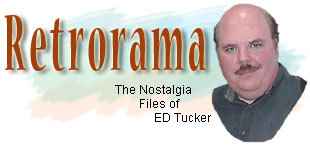 By 1968, Irwin Allen had already explored the depths of the ocean, the farthest reaches of space, and even the paths of time in his television series. Always the innovator, Allen decided that for his next show he would concentrate on a single alien planet and some castaways from Earth trapped on it. In much the way the Swiss Family Robinson classic novel had served as an inspiration for Lost in Space, Allen turned to Gulliver’s Travels this time, specifically the portion where Lemuel Gulliver finds himself the size of a doll as compared to a race of giants he encounters known as the Brobdingnags. Transposing the story to an alien planet inhabited by giants menacing the diminutive crew and passengers of a crashed Earth spaceship, Allen created a new series he called Land of the Giants.
By 1968, Irwin Allen had already explored the depths of the ocean, the farthest reaches of space, and even the paths of time in his television series. Always the innovator, Allen decided that for his next show he would concentrate on a single alien planet and some castaways from Earth trapped on it. In much the way the Swiss Family Robinson classic novel had served as an inspiration for Lost in Space, Allen turned to Gulliver’s Travels this time, specifically the portion where Lemuel Gulliver finds himself the size of a doll as compared to a race of giants he encounters known as the Brobdingnags. Transposing the story to an alien planet inhabited by giants menacing the diminutive crew and passengers of a crashed Earth spaceship, Allen created a new series he called Land of the Giants.
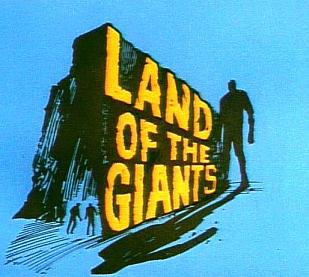 The ABC Television Network was interested in a fifth season of Voyage to the Bottom of the Sea when its fourth came to a close in the first half of 1968. Irwin Allen felt that he had mined the underwater adventure series for all the stories he could get so he pitched a replacement show to the network instead. Creating a pilot film composed mainly of concept art and special effects footage garnered from other shows like Lost in Space, Allen sold them on the idea of an exciting new concept that had never been explored in a weekly television series before. Land of the Giants promised big thrills from a tiny cast but at $250,000 per episode it was also the most expensive series ever put on television up to that time. Allen was a master at stock footage and reusing props but he had very few oversized pencils, telephones, and matchboxes in his warehouse when the series began production.
The ABC Television Network was interested in a fifth season of Voyage to the Bottom of the Sea when its fourth came to a close in the first half of 1968. Irwin Allen felt that he had mined the underwater adventure series for all the stories he could get so he pitched a replacement show to the network instead. Creating a pilot film composed mainly of concept art and special effects footage garnered from other shows like Lost in Space, Allen sold them on the idea of an exciting new concept that had never been explored in a weekly television series before. Land of the Giants promised big thrills from a tiny cast but at $250,000 per episode it was also the most expensive series ever put on television up to that time. Allen was a master at stock footage and reusing props but he had very few oversized pencils, telephones, and matchboxes in his warehouse when the series began production.
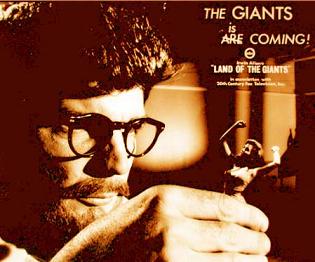 In the far distant future of 1983, the United States commercial space liner Spindrift is on a routine flight shuttling passengers between Los Angeles and London. On board are Captain Steve Burton (Gary Conway), Co-Pilot Dan Erickson (Don Marshall), and Flight Attendant Betty Hamilton (Heather Young). The passengers include engineer Mark Wilson (Don Matheson), socialite Valerie Scott (Deanna Lund), a supposed Navy Commander Alexander Fitzhugh (Kurt Kasznar), young Barry Lockridge (Stefan Arngrim) and his dog Chipper. As the ship is following its familiar flight plan between destinations, it passes through a freak space storm the causes the navigational instruments to go haywire. Once the crew regains control and stabilizes the craft, they realize something is wrong and they are badly off course. After a rocky landing, the group discovers that they are now on a world filled with giants and they are less than a foot tall by comparison!
In the far distant future of 1983, the United States commercial space liner Spindrift is on a routine flight shuttling passengers between Los Angeles and London. On board are Captain Steve Burton (Gary Conway), Co-Pilot Dan Erickson (Don Marshall), and Flight Attendant Betty Hamilton (Heather Young). The passengers include engineer Mark Wilson (Don Matheson), socialite Valerie Scott (Deanna Lund), a supposed Navy Commander Alexander Fitzhugh (Kurt Kasznar), young Barry Lockridge (Stefan Arngrim) and his dog Chipper. As the ship is following its familiar flight plan between destinations, it passes through a freak space storm the causes the navigational instruments to go haywire. Once the crew regains control and stabilizes the craft, they realize something is wrong and they are badly off course. After a rocky landing, the group discovers that they are now on a world filled with giants and they are less than a foot tall by comparison!
The giant’s land is very similar to Earth but there appears to be one totalitarian government and their science and technology is advanced beyond our own. The “little people”, as the giants call them, are hunted by the government presumably to keep the general population from suspecting their may be other worlds beyond their own. Unable to repair or properly fuel their ship, the group from the Spindrift must avoid detection and hope that they can one discover a way to return home.
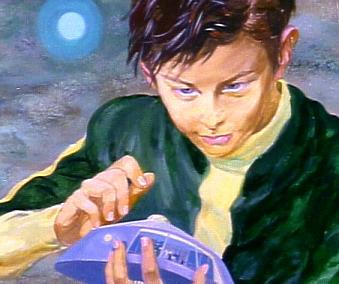
A rare concept drawing from the Land of the Giants sales film. Notice the Spindrift looks suspiciously like the Jupiter II!
Like earlier Irwin Allen series, Land of the Giants started out trying to tell serious science fiction stories but quickly succumbed to gimmick driven plots. Where Lost in Space developed a core dynamic of Will Robinson, Dr. Smith, and the robot, Land of the Giants had Barry, Alexander Fitzhugh, and Chipper the dog! Fitzhugh’s character was never fully fleshed out but he was apparently a confidence man who acquired a sizable amount of cash in one of his schemes and was attempting to make his escape disguised as Navy Commander. Early on he is armed with a gun and not beyond physical confrontation with the other passengers and crew but once the bizarre circumstances of their current situation sink in with him he reverts to a bumbling, conniving coward in the Dr. Smith mold. The heroics are left up to the resourceful crew and Mark Wilson who is reveled to have been involved in the creation of ships like the Spindrift and proves an invaluable asset to their group.
The plot of a typical episode of Land of the Giants had one or more of the little people captured by the giants and the rest of the group trying to rescue them. Sometimes they would find themselves in a house or town that was their own scale, to save on prop money, or running across a benevolent giant and forming a mutually beneficial, if short lived, relationship. All the while this was going on; they were being pursued by Inspector Kobick (played by Kevin Hagen best known as friendly Doc Baker on Little House on the Prairie) a government agent from the SID (Special Investigations Department) who wants them for some mysterious purpose.
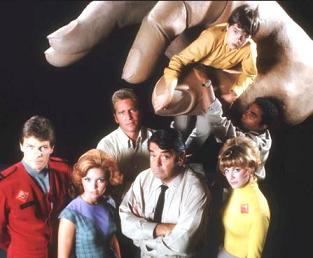
The cast of Land of the Giants.
The Spindrift’s occupants were not the only little people this world had seen either. On several occasions they ran across other misplaced space travelers who were either from Earth or some place very similar to it. This fact wasn’t lost on the giants either and while it wasn’t explicitly mentioned, it was implied that many more diminutive castaways may have been captured or killed. In The Golden Cage, an attractive female survivor from an earlier crash is used as bait to lure the male members of the party into a trap. For The Lost Ones, a stranded group of teenage delinquents from Earth coerce the group into helping them rescue one of their members captured by the giants. In true television fashion, at the conclusion of the episode the youths go their separate ways never to be seen or mentioned again.
Land of the Giants relied on guest stars more than any of Irwin Allen’s other series and by the late 60’s they had plenty to choose from with popular actors from recently canceled television shows. Ron Howard, Lee Meriwether and Robert Colbert (from The Time Tunnel), John Caradine, Zalman King, Alan Hale Jr., Albert Salmi, and even Jonathan Harris (from Lost in Space) appeared as giants who sometimes helped by more often menaced the little people.
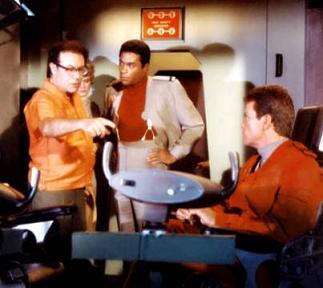
Irwin Allen directs the pilot episode "The Crash"
Land of the Giants was almost guaranteed a second season thanks to the investment that had been made creating props for the first one. Season two boasted a more dynamic opening credit sequence highlighting many of the obstacles our heroes had run into. While not much was changed in the way of sets or costuming, other than the Spindrift becoming increasingly atrophied, the plots did start to take the characters outside of their immediate surroundings and into some fresh territories. Where many of the first season episodes had relied heavily on the government pursuit angle, stories for the second season pitted the little people against robots, clones, killer toys, and a wide variety of new technologies that caused them to grow to giant size, turn invisible and even briefly return to Earth at one point.
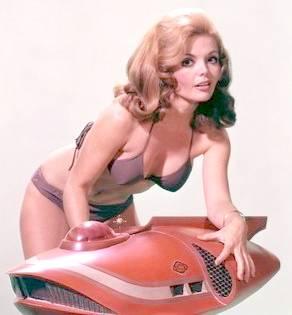
Maybe Land of the Giants wasn't intended as an entirely family friendly show judging by this publicity photo of Deanna Lund!
Most of the episodes of Land of the Giants were pretty standard fair that relied more on gimmicks than drama. There were a few exceptions though like Ghost Town, broadcast as the second episode because the network recognized its potential, where the little people find an entire town built to their scale. This episode manages to convey a little mystery that was missing from most of the shows especially when seen early in the run. During the second season, the little people end up way off their home turf after a runaway balloon ride in Land of the Lost. One of the best episodes of the series was near the end of the run and pitted the little people against a young giant with a pretty impressive arsenal of toys. In A Small War, the boy believes he is engaged in a skirmish with a rival youth when he is actually playing a lethal game with the tiny travelers. In addition to giving the little people some enemies of their own scale, this episode also showcased their resourcefulness and teamwork. This is the only episode of Land of the Giants, or any Irwin Allen show, that I remember seeing during its original network broadcast when I was very young and it made a big impression on me.
As the 1960’s came to and end, so did Land of the Giants and Irwin Allen’s reign on television for over half a decade. While Giants received decent ratings, they were not enough to justify a third season at its considerable budget and audiences of the early 1970’s were moving away from fantasy shows and more towards realistic crime and drama series. Irwin Allen took a break from weekly television shows for many years and focused instead on big screen disaster films that introduced him to a whole new audience. He may have become the Master of Disaster to movie audiences but to the generation of children who grew up watching his television shows in prime time and the multiple more who saw them for years afterward in syndication, he will always be fondly remembered for the fantasy worlds he created.
